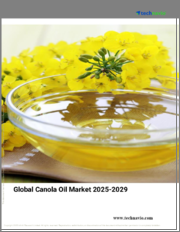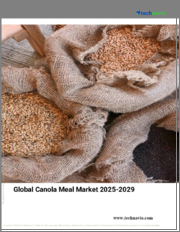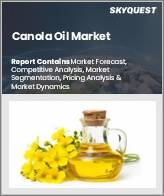
|
시장보고서
상품코드
1511320
세계의 캐놀라밀 시장 예측 : 유형별, 용도별, 지역별(-2030년)Canola Meal Market Forecasts to 2030 - Global Analysis By Type, Application and By Geography |
||||||
Stratistics MRC에 따르면 세계 캐놀라밀 시장은 2024년에 93억 7,000만 달러를 차지하고 예측 기간 동안 CAGR은 6.5%로 성장하여 2030년에는 136억 8,000만 달러에 이를 것으로 예상됩니다.
캐놀라밀은 유채의 일종인 카놀라 씨로부터 기름을 추출하는 과정에서 생기는 고단백질 부산물입니다. 기름을 짜낸 후, 남은 원료는 미세하게 분쇄됩니다. 가축 사료, 특히 가금류, 돼지, 소의 사료로서 귀중한 단백질원이 됩니다. 단백질 함량은 36%에서 44%로 동물의 성장과 발육에 필요한 필수 아미노산을 포함하고 있습니다. 게다가 적당한 섬유질과 에너지도 포함되어 있으며, 동물용 사료 전체의 영양 균형에 공헌하고 있습니다.
가축 사료 수요 증가
캐놀라밀은 카놀라 씨앗에서 기름을 추출하는 과정에서 할 수 있는 부산물로, 가축, 특히 가금류, 돼지, 소의 사료로서 우수한 단백질원이 됩니다. 세계 인구 증가와 단백질이 풍부한 식단에 대한 선호의 변화로 인해 육류 제품 수요가 급증하고 캐놀라밀과 같은 고품질의 가축 사료 원료에 대한 요구가 높아지고 있습니다. 높은 단백질이며 필수 아미노산과 낮은 수준의 항 영양 인자를 포함하는 캐놀라밀은 동물 영양학에 매력적인 선택입니다.
원재료 가격 변동
원재료 가격의 변동은 캐놀라밀 시장에 큰 도전을 가져왔습니다. 캐놀라밀은 캐놀라 씨앗을 분쇄하여 얻을 수 있지만, 주요 원료 인 캐놀라 씨앗의 안정적인 가격에 크게 의존합니다. 날씨, 지정학적 긴장, 세계 수급관계 등의 요인에 좌우되는 원료 가격의 변동은 시장의 안정을 방해합니다. 캐놀라 씨앗의 가격이 상승하면 제조업체는 종종 생산 비용 증가에 직면하여 캐놀라밀 제품의 가격 상승으로 이어집니다. 그 결과 가격에 민감한 소비자 수요가 줄어들어 대체품을 요구하게 됩니다.
작물 유전학의 기술 진보
유전자 재조합이나 선발 육종 등의 기술에 의해 과학자는 고단백질 함유, 영양가의 향상, 병해충에의 저항성 등, 개량된 형질을 가지는 캐놀라 식물을 개발할 수 있습니다. 이러한 발전은 에이커당 수율 증가, 생산 비용 절감, 사료, 식품 가공, 바이오연료 생산 등 다양한 용도에 사용되는 고품질 캐놀라밀의 안정적인 공급으로 이어지고 있습니다. 게다가 유전자 공학은 특정 환경 조건에 맞는 캐놀라 품종의 개발을 가능하게 하고, 재배의 기회가 세계적으로 확대하고 있습니다.
날씨 위험
날씨 위험은 캐놀라밀 시장에 큰 도전을 가져오고 생산과 품질 모두에 영향을 미칩니다. 캐놀라는 기상 조건에 매우 민감한 작물이기 때문에 가뭄, 과도한 강우, 온도 변화 등 악천후로 인한 위협에 직면합니다. 이러한 현상은 제작 일정을 미치고 수확량을 줄이고 수확된 캐놀라의 전반적인 품질에 영향을 줄 수 있습니다. 예를 들어, 가뭄은 식물에 물 스트레스를 일으켜 수율 가능성을 낮추는 반면, 과도한 강우는 샘물을 유발하여 질병의 위험을 증가시킬 수 있습니다.
COVID-19의 영향:
세계 각지에서 봉쇄 조치 및 이동 제한이 실시되어 세계 공급망에 혼란이 생겨 생산과 유통 모두에 영향을 미쳤습니다. 운송 능력의 저하로 소비자에게 캐놀라밀의 적시 배송이 방해되어 수급 변동으로 이어졌습니다. 또한 소비 지출의 감소와 식생활의 기호의 변화 등 소비자 행동의 변화도 시장 동향에 영향을 미쳤습니다. 레스토랑, 호텔 및 기타 외식 시설의 폐쇄는 식품의 원재료로 캐놀라밀 수요를 감소시켰지만, 가정에서의 요리와 과자 만들기 증가는 소매 패키지 상품 수요에 박차를 가했습니다.
예측 기간 동안 유기 캐놀라밀 부문이 최대가 될 전망
유기 캐놀라밀 부문은 예측 기간 동안 최대가 될 것으로 예상됩니다. 유기 캐놀라밀은 합성 농약과 화학 비료, 유전자 변형 작물(GMO) 및 기타 유해한 화학 물질을 사용하지 않는 등 몇 가지 장점이 있습니다. 이것은 식생활에서 자연스럽고 친환경 제품을 선호하는 건강 지향 소비자에게 호소합니다. 또한 유기 인증은 소비자에게 제품의 신뢰성과 엄격한 유기농법 준수를 보장하고 신뢰와 충성심을 키웁니다.
토양 개선 부문은 예측 기간 중 가장 높은 CAGR이 예상된다.
토양 개선 부문은 예측 기간 동안 가장 높은 CAGR이 예상됩니다. 캐놀라 씨앗에서 기름을 추출한 부산물인 캐놀라밀은 단백질과 영양소가 풍부하며 가축 사료에 이상적입니다. 캐놀라밀을 강화한 퇴비와 바이오차 등의 토양 개량 제품은 토양의 비옥도, 구조, 보수 능력을 향상시킵니다. 캐놀라밀을 이러한 개선된 재료에 통합함으로써, 농부들은 화학 합성 비료에 대한 의존도를 감소시키면서 토양의 건전성을 향상시킬 수 있습니다. 이는 농작물의 생산성을 높일 뿐만 아니라 화학비료의 유출과 토양의 열화를 최소화함으로써 환경의 지속가능성을 촉진합니다.
최대 점유율을 차지하는 지역:
영양과 건강의 중요성에 대한 의식이 높아짐에 따라 소비자는 식생활의 기호에 맞는 제품을 요구하게 되었습니다. 캐놀라밀은 풍부한 단백질 공급원이며 포화 지방산이 적기 때문에 지역 전체의 건강한 식습관의 틀 안에 잘 들어가기 때문에 수요가 급증하고 있습니다. 이러한 소비자 행동의 변화는 시장 환경을 재구성할 뿐만 아니라 아시아태평양에서 캐놀라밀 제품의 생산과 유통에 있어서의 혁신과 투자를 촉진하고 있습니다.
CAGR이 가장 높은 지역:
북미는 예상되는 기간 동안 수익성이 높은 성장을 유지할 전망입니다. 생산, 유통, 표시에 대한 기준과 지침을 부과함으로써 정부는 캐놀라밀 제품의 품질과 안전을 보장합니다. 이러한 규제는 소비자의 신뢰를 키우고 이 지역 내에서의 소비와 거래 증가를 촉진합니다. 게다가 규제 체제는 시장 관계자들 간의 공정한 경쟁을 촉진하고 독점을 방지하며 모든 이해관계자들에게 공정한 경쟁 환경을 확보합니다.
무료 맞춤형 서비스
이 보고서를 구독하는 고객은 다음 무료 맞춤설정 옵션 중 하나를 사용할 수 있습니다.
- 기업 프로파일
- 추가 시장 기업의 종합적 프로파일링(3개사까지)
- 주요 기업의 SWOT 분석(3개사까지)
- 지역 세분화
- 고객의 관심에 응한 주요국 시장 추계·예측·CAGR(주: 타당성 확인에 따름)
- 경쟁 벤치마킹
- 제품 포트폴리오, 지리적 존재, 전략적 제휴에 기반한 주요 기업 벤치마킹
목차
제1장 주요 요약
제2장 서문
- 개요
- 이해관계자
- 조사 범위
- 조사 방법
- 데이터 마이닝
- 데이터 분석
- 데이터 검증
- 조사 접근
- 조사 정보원
- 1차 조사 정보원
- 2차 조사 정보원
- 전제조건
제3장 시장 동향 분석
- 성장 촉진요인
- 억제요인
- 기회
- 위협
- 용도 분석
- 신흥 시장
- COVID-19의 영향
제4장 Porter's Five Forces 분석
- 공급기업의 협상력
- 구매자의 협상력
- 대체품의 위협
- 신규 진입업자의 위협
- 경쟁 기업간 경쟁 관계
제5장 세계의 캐놀라밀 시장 : 유형별
- 기존
- 유기
- 압착
- 용매 추출
- 고단백질
- 저온 처리
- 기타
제6장 세계의 캐놀라밀 시장 : 용도별
- 도매
- 소매
- 영양보조식품
- 토양 개량
- 기타
제7장 세계의 캐놀라밀 시장 : 지역별
- 북미
- 미국
- 캐나다
- 멕시코
- 유럽
- 독일
- 영국
- 이탈리아
- 프랑스
- 스페인
- 기타 유럽
- 아시아태평양
- 일본
- 중국
- 인도
- 호주
- 뉴질랜드
- 한국
- 기타 아시아태평양
- 남미
- 아르헨티나
- 브라질
- 칠레
- 기타 남미
- 중동 및 아프리카
- 사우디아라비아
- 아랍에미리트(UAE)
- 카타르
- 남아프리카
- 기타 중동 및 아프리카
제8장 주요 발전
- 계약/파트너십/협업/합작투자(JV)
- 인수와 합병
- 신제품 발매
- 사업 확대
- 기타 주요 전략
제9장 기업 프로파일링
- Ag Processing Inc
- Archer Daniels Midland Company
- Bunge Limited
- Burcon NutraScience Corporation
- Cargill, Incorporated
- COFCO Corporation
- GrainCorp Limited
- Itochu Corporation
- Land O'Lakes, Inc
- Louis Dreyfus Company
- MP Evans Group PLC
- Oilseeds International Ltd
- Parrish and Heimbecker, Limited
- Richardson International Limited
- The Scoular Company
- Wilmar International Limited
According to Stratistics MRC, the Global Canola Meal Market is accounted for $9.37 billion in 2024 and is expected to reach $13.68 billion by 2030 growing at a CAGR of 6.5% during the forecast period. Canola meal is a high-protein byproduct of the oil extraction process from canola seeds, a type of rapeseed. After the oil is pressed out, the remaining material is ground into a fine meal. It serves as a valuable source of protein for livestock feed, particularly in diets for poultry, swine, and cattle. With a protein content ranging from 36% to 44%, canola meal provides essential amino acids necessary for animal growth and development. Additionally, it contains moderate levels of fiber and energy, contributing to overall nutritional balance in animal diets.
Market Dynamics:
Driver:
Rising demand for livestock feed
Canola meal, a byproduct of the oil extraction process from canola seeds, serves as an excellent protein source for livestock, particularly in poultry, swine, and cattle diets. With the global population increasing and dietary preferences shifting towards protein-rich diets, the demand for meat products has surged, subsequently driving the need for high-quality livestock feed ingredients like canola meal. Its high protein content, along with essential amino acids and low levels of anti-nutritional factors, makes it an attractive choice for animal nutrition.
Restraint:
Fluctuations in the prices of raw materials
Fluctuations in raw material prices pose a significant challenge to the Canola Meal Market. Canola meal, derived from crushing canola seeds, relies heavily on stable prices of its primary input, canola seeds. Volatility in raw material prices, influenced by factors such as weather conditions, geopolitical tensions, and global demand-supply dynamics, disrupts the market's stability. When canola seed prices surge, manufacturers often face increased production costs, which can lead to higher prices for canola meal products. This, in turn, reduces demand from price-sensitive consumers and may prompt them to seek alternatives.
Opportunity:
Technological advancements in crop genetics
Through techniques like genetic modification and selective breeding, scientists can develop canola plants with improved traits such as higher protein content, enhanced nutritional value, and resistance to pests and diseases. These advancements lead to increased yields per acre, reduced production costs, and a more consistent supply of high-quality canola meal for various applications including animal feed, food processing, and biofuel production. Moreover, genetic engineering allows for the development of canola varieties tailored to specific environmental conditions, expanding cultivation opportunities globally.
Threat:
Weather risks
Weather risks pose a significant challenge to the Canola Meal Market, impacting both production and quality. Canola, being a crop highly sensitive to weather conditions, faces threats from adverse weather events such as droughts, excessive rainfall, and temperature fluctuations. These phenomena can disrupt planting schedules, reduce crop yields, and affect the overall quality of the canola harvested. Droughts, for instance, can lead to water stress in plants, diminishing yield potential, while excessive rainfall may cause waterlogging and increase the risk of diseases.
Covid-19 Impact:
With lockdown measures and restrictions on movement implemented worldwide, disruptions occurred in the global supply chain, affecting both production and distribution. Reduced transportation capabilities hindered the timely delivery of canola meal to consumers, leading to fluctuations in supply and demand dynamics. Additionally, shifts in consumer behavior, such as reduced spending and changes in dietary preferences, influenced market trends. The closure of restaurants, hotels, and other foodservice establishments resulted in a decline in demand for canola meal as an ingredient in food products, while increased home cooking and baking spurred demand for retail-packaged goods.
The Organic Canola Meal segment is expected to be the largest during the forecast period
Organic Canola Meal segment is expected to be the largest during the forecast period. Organic Canola Meal offers several advantages, including being free from synthetic pesticides and fertilizers, genetically modified organisms (GMOs), and other harmful chemicals. This appeals to health-conscious consumers who prioritize natural and environmentally friendly products in their diet. Additionally, the organic certification assures consumers of the product's authenticity and adherence to strict organic farming practices, thereby fostering trust and loyalty.
The Soil Amendment segment is expected to have the highest CAGR during the forecast period
Soil Amendment segment is expected to have the highest CAGR during the forecast period. Canola meal, a byproduct of oil extraction from canola seeds, is rich in protein and nutrients, making it an excellent choice for animal feed. Soil amendment products, such as compost and biochar enriched with canola meal, improve soil fertility, structure, and water retention capabilities. By incorporating canola meal into these amendments, farmers can enhance soil health while reducing the reliance on synthetic fertilizers. This not only benefits crop productivity but also promotes environmental sustainability by minimizing chemical runoff and soil degradation.
Region with largest share:
As awareness about the importance of nutrition and health grows, consumers are increasingly seeking out products that align with their dietary preferences, Asia Pacific region commanded the largest share of the market over the projection period. Canola meal, being a rich source of protein and low in saturated fats, is witnessing a surge in demand as it fits well within the framework of healthier eating habits across the region. This shift in consumer behavior is not only reshaping the market landscape but also encouraging innovation and investment in the production and distribution of canola meal products across the Asia Pacific region.
Region with highest CAGR:
North America region is poised to hold profitable growth over the extrapolated period. By imposing standards and guidelines on production, distribution, and labeling, governments ensure the quality and safety of canola meal products. These regulations foster consumer confidence, encouraging increased consumption and trade within the region. Additionally, regulatory frameworks promote fair competition among market players, preventing monopolies and ensuring a level playing field for all stakeholders.
Key players in the market
Some of the key players in Canola Meal market include Ag Processing Inc, Archer Daniels Midland Company, Bunge Limited, Burcon NutraScience Corporation, Cargill, Incorporated, COFCO Corporation, GrainCorp Limited, Itochu Corporation, Land O'Lakes, Inc, Louis Dreyfus Company, M.P. Evans Group PLC, Oilseeds International Ltd, Parrish and Heimbecker, Limited, Richardson International Limited, The Scoular Company and Wilmar International Limited.
Key Developments:
In September 2023, ADM, a global leader in nutrition and agricultural origination and processing, and Syngenta Group, one of the world's biggest agricultural technology companies, announced they have signed a memorandum of understanding (MoU) to collaborate in scaling research and commercialization of low carbon-intensity next-generation oilseeds and improved varieties to help meet skyrocketing demand for biofuels and other sustainably-sourced products.
Types Covered:
- Conventional Canola Meal
- Organic Canola Meal
- Expeller-Pressed Canola Meal
- Solvent-Extracted Canola Meal
- High-Protein Canola Meal
- Low-Temperature Processed Canola Meal
- Other Types
Applications Covered:
- Wholesale
- Retail
- Nutritional Supplements
- Soil Amendment
- Other Applications
Regions Covered:
- North America
- US
- Canada
- Mexico
- Europe
- Germany
- UK
- Italy
- France
- Spain
- Rest of Europe
- Asia Pacific
- Japan
- China
- India
- Australia
- New Zealand
- South Korea
- Rest of Asia Pacific
- South America
- Argentina
- Brazil
- Chile
- Rest of South America
- Middle East & Africa
- Saudi Arabia
- UAE
- Qatar
- South Africa
- Rest of Middle East & Africa
What our report offers:
- Market share assessments for the regional and country-level segments
- Strategic recommendations for the new entrants
- Covers Market data for the years 2022, 2023, 2024, 2026, and 2030
- Market Trends (Drivers, Constraints, Opportunities, Threats, Challenges, Investment Opportunities, and recommendations)
- Strategic recommendations in key business segments based on the market estimations
- Competitive landscaping mapping the key common trends
- Company profiling with detailed strategies, financials, and recent developments
- Supply chain trends mapping the latest technological advancements
Free Customization Offerings:
All the customers of this report will be entitled to receive one of the following free customization options:
- Company Profiling
- Comprehensive profiling of additional market players (up to 3)
- SWOT Analysis of key players (up to 3)
- Regional Segmentation
- Market estimations, Forecasts and CAGR of any prominent country as per the client's interest (Note: Depends on feasibility check)
- Competitive Benchmarking
- Benchmarking of key players based on product portfolio, geographical presence, and strategic alliances
Table of Contents
1 Executive Summary
2 Preface
- 2.1 Abstract
- 2.2 Stake Holders
- 2.3 Research Scope
- 2.4 Research Methodology
- 2.4.1 Data Mining
- 2.4.2 Data Analysis
- 2.4.3 Data Validation
- 2.4.4 Research Approach
- 2.5 Research Sources
- 2.5.1 Primary Research Sources
- 2.5.2 Secondary Research Sources
- 2.5.3 Assumptions
3 Market Trend Analysis
- 3.1 Introduction
- 3.2 Drivers
- 3.3 Restraints
- 3.4 Opportunities
- 3.5 Threats
- 3.6 Application Analysis
- 3.7 Emerging Markets
- 3.8 Impact of Covid-19
4 Porters Five Force Analysis
- 4.1 Bargaining power of suppliers
- 4.2 Bargaining power of buyers
- 4.3 Threat of substitutes
- 4.4 Threat of new entrants
- 4.5 Competitive rivalry
5 Global Canola Meal Market, By Type
- 5.1 Introduction
- 5.2 Conventional Canola Meal
- 5.3 Organic Canola Meal
- 5.4 Expeller-Pressed Canola Meal
- 5.5 Solvent-Extracted Canola Meal
- 5.6 High-Protein Canola Meal
- 5.7 Low-Temperature Processed Canola Meal
- 5.8 Other Types
6 Global Canola Meal Market, By Application
- 6.1 Introduction
- 6.2 Wholesale
- 6.3 Retail
- 6.4 Nutritional Supplements
- 6.5 Soil Amendment
- 6.6 Other Applications
7 Global Canola Meal Market, By Geography
- 7.1 Introduction
- 7.2 North America
- 7.2.1 US
- 7.2.2 Canada
- 7.2.3 Mexico
- 7.3 Europe
- 7.3.1 Germany
- 7.3.2 UK
- 7.3.3 Italy
- 7.3.4 France
- 7.3.5 Spain
- 7.3.6 Rest of Europe
- 7.4 Asia Pacific
- 7.4.1 Japan
- 7.4.2 China
- 7.4.3 India
- 7.4.4 Australia
- 7.4.5 New Zealand
- 7.4.6 South Korea
- 7.4.7 Rest of Asia Pacific
- 7.5 South America
- 7.5.1 Argentina
- 7.5.2 Brazil
- 7.5.3 Chile
- 7.5.4 Rest of South America
- 7.6 Middle East & Africa
- 7.6.1 Saudi Arabia
- 7.6.2 UAE
- 7.6.3 Qatar
- 7.6.4 South Africa
- 7.6.5 Rest of Middle East & Africa
8 Key Developments
- 8.1 Agreements, Partnerships, Collaborations and Joint Ventures
- 8.2 Acquisitions & Mergers
- 8.3 New Product Launch
- 8.4 Expansions
- 8.5 Other Key Strategies
9 Company Profiling
- 9.1 Ag Processing Inc
- 9.2 Archer Daniels Midland Company
- 9.3 Bunge Limited
- 9.4 Burcon NutraScience Corporation
- 9.5 Cargill, Incorporated
- 9.6 COFCO Corporation
- 9.7 GrainCorp Limited
- 9.8 Itochu Corporation
- 9.9 Land O'Lakes, Inc
- 9.10 Louis Dreyfus Company
- 9.11 M.P. Evans Group PLC
- 9.12 Oilseeds International Ltd
- 9.13 Parrish and Heimbecker, Limited
- 9.14 Richardson International Limited
- 9.15 The Scoular Company
- 9.16 Wilmar International Limited

















